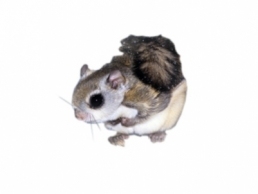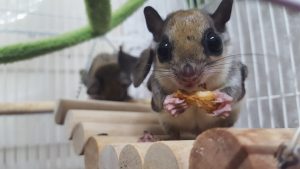
3 Ways to Identify A Flying Squirrel
 Two flying squirrel species are found in the Greater Boston and surrounding areas: the northern and southern flying squirrel.
Two flying squirrel species are found in the Greater Boston and surrounding areas: the northern and southern flying squirrel.- These rodents are not capable of true flight like birds or bats; the way they move is actually more of a glide.
- Though they are actually quite common throughout the United States, flying squirrels are rarely encountered by humans because they are nocturnal.
What Do Flying Squirrels Look Like?
- Gray or brown fur
- Bellies of northern flying squirrels typically are gray.
- Southern flying squirrel undersides are white.
- These rodents can grow between 8–14 inches (20–35 cm) long, with their tails accounting for at least half their length, and northern flying squirrels are usually about two inches longer than their southern cousins.
- They have flattened tails that they use as brakes while gliding.
- Flaps of skin that extend from their ankles to their wrists that function similarly to parachutes.
- Their huge eyes allow them to see very well in the dark.
Where Do Flying Squirrels Live?
- Southern flying squirrels prefer to nest in forests of seed-producing hardwood trees where they feed on fruit and nuts from trees such as red and white oak, hickory, and beech.
- Northern flying squirrels live in coniferous and mixed forests, and feed on fungi of many different species, though they also eat lichens, mushrooms, all mast-crop nuts, sap, insects, dead animals, bird eggs and nestlings, buds and flowers.
- Both species build nests out of twigs, bark, feathers, fur, and leaves in abandoned bird nests, dying trees, and woodpecker holes.
Flying Squirrel Problems
How Flying Squirrels Make Entry
Do flying squirrels get in houses?
- Flying squirrels often create nests in ornamental and shade trees on lawns, in barns and sheds, and in attics.
- They may also take up residence in parks, golf courses, and other areas with constant human activity and sufficient greenery, though flying squirrels are nocturnal and are rarely seen by people.
What type of damage can flying squirrels cause?
- Since flying squirrels help spread fungi spores and tree seeds, they are largely considered beneficial.
- However, they become problematic when they move onto lawns and into attics, causing quite a large ruckus at night.
- Additionally, their urine smells strong and can carry harmful bacteria.
- Flying squirrels also gnaw on walls, structural support beams, and electrical wires.
Flying Squirrel Removal and Safety
Flying Squirrel Control and Safety
- Residents can make home or yard modifications to make sure the surrounding area won’t attract flying squirrels.
- Close up any and all possible entry points to homes by covering small openings, sealing cracks, replacing broken windows and door screens, and adding screens to vents and chimneys.
- Remove any possible food sources by fitting indoor and outdoor trash bins with tightly-sealed lids. Finally, restrict flying squirrel access to roofs by trimming tree branches that hang over or close to rooftops.
Flying Squirrel Trapping and Removal
Although humans and flying squirrels are generally able to coexist peacefully, females become aggressive when they feel their territory has been threatened. Untrained individuals should never attempt to approach the wild animals as interaction may result in injury or disease. Call the technicians at Critter Control for the humane and safe removal of flying squirrels from private property.
We can help you get rid of flying squirrel problems today!




